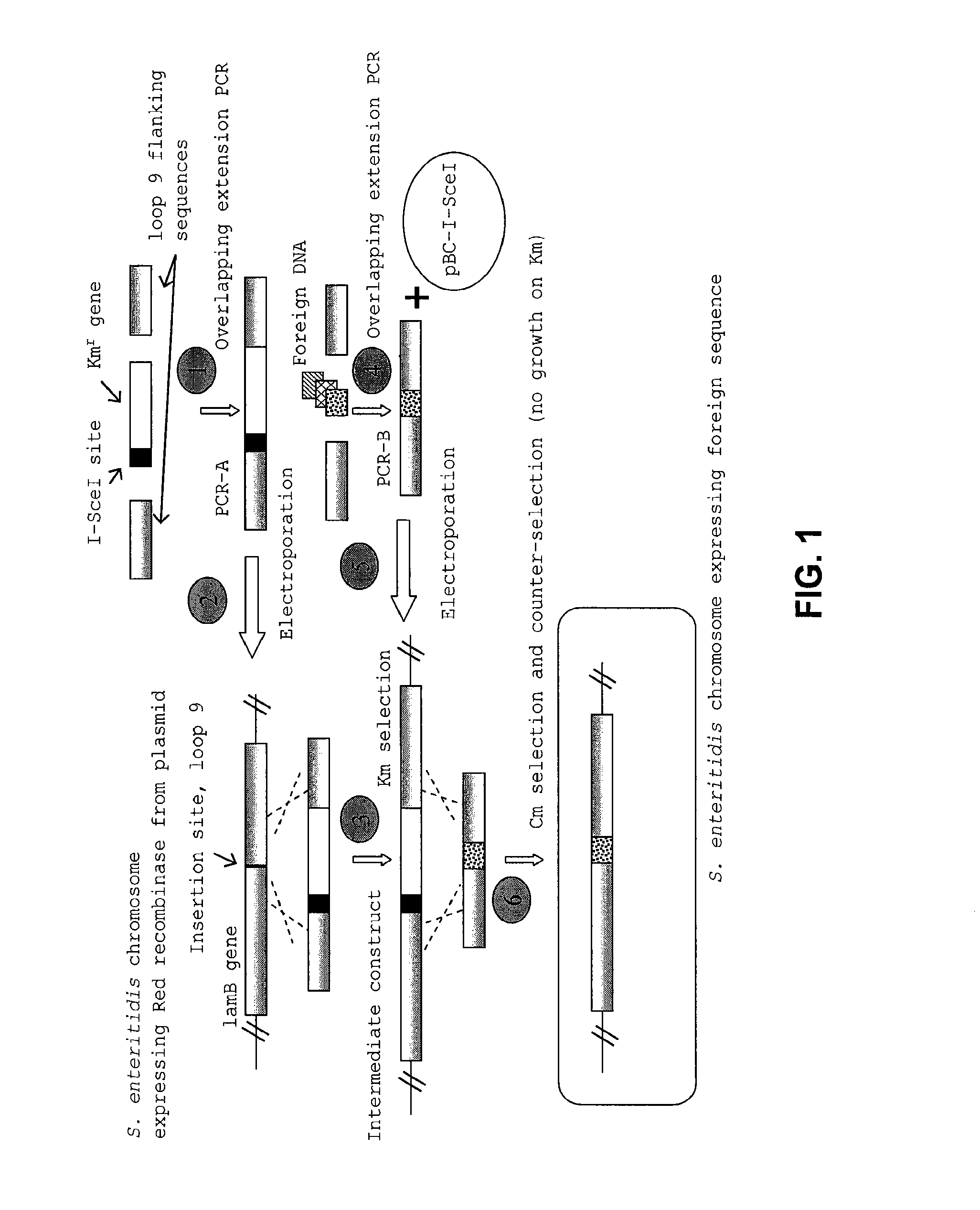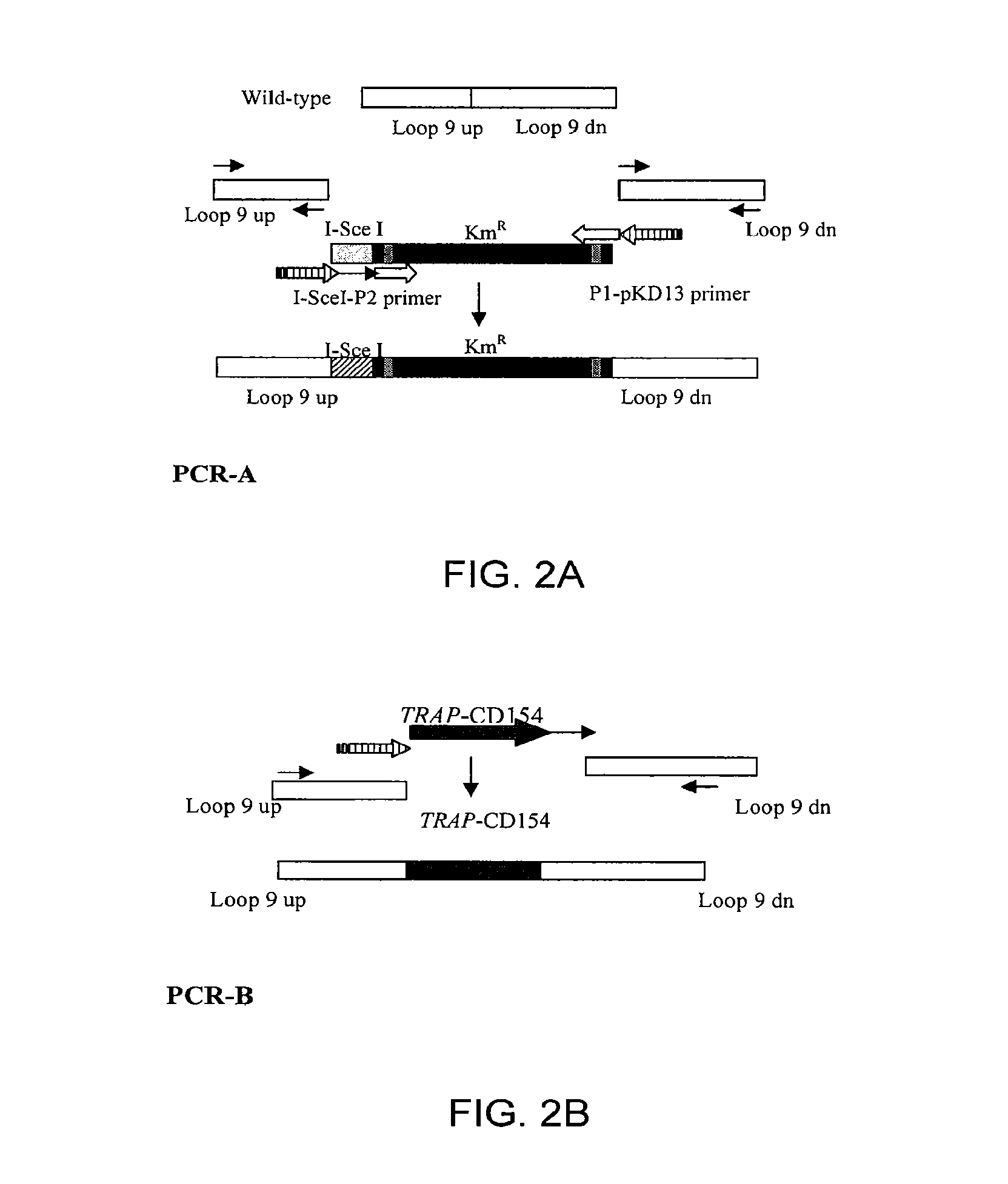Compositions and methods of enhancing immune responses to Eimeria
a technology of immune response and composition, applied in the field of composition and method of enhancing immune response of i>eimeria/i>, can solve the problems of economic loss, substantial vaccine-reaction morbidity, and worldwide vaccination of current i>eimeria/i>-based vaccines, and achieve the effect of enhancing immune response and reducing morbidity
- Summary
- Abstract
- Description
- Claims
- Application Information
AI Technical Summary
Benefits of technology
Problems solved by technology
Method used
Image
Examples
example 1
Construction of TRAP and TRAP / CD154 Inserts
Strains and Culture Conditions
[0043]All plasmids were first maintained in TOP 10 E. coli cells (Invitrogen, Carlsbad, Calif., USA) unless described otherwise. Salmonella enteritidis 13A was used for introduction of mutations. Salmonella enteritidis strain 13A was a field isolate available from USDA / APHIS / NVSL and deposited with the ATCC as deposit number PTA-7871. Bacteria carrying plasmid pKD46 were grown at 30° C. Other bacteria were grown at 37° C. Plasmid curing was conducted at 37° C.
[0044]Luria-Bertani (LB) media was used for routine growth of cells, and SOC media (Invitrogen, Carlsbad, Calif., USA) was used for phenotypic expression after electroporation. When appropriate, the following antibiotics were added to the media: ampicillin (Amp) at 100 μg / ml, kanamycin (Km) at 50 μg / ml, and chloramphenicol (Cm) at 25 μg / ml.
Plasmids
[0045]Plasmids pKD46, pKD13, and pBC-1-SceI were described previously (Datsenko and Wanner, PNAS 2000, 97:6640...
example 2
Attenuation of TRAP-CD154 Mutants / Inserts
[0054]Attenuation of SE13A was achieved by deletion mutation of the aroA gene and / or the htrA gene. Mutation of the aroA gene, a key gene in the chorismic acid pathway of bacteria, results in a severe metabolic deficiency which affects seven separate biochemical pathways. Mutation of the htrA gene reduces the cell's ability to withstand exposure to low and high temperatures, low pH, and oxidative and DNA damaging agents and reduces the bacteria's virulence.
[0055]To achieve deletion mutations in SE13A, the target gene sequence in the bacterial genome of S. enteritidis was replaced with the Km resistant gene sequence. This was completed using overlapping extension PCR and electroporation of the PCR products as described above. The Km resistance gene was targeted into the genomic region containing the genes of interest (aroA or htrA) by flanking the Km resistance gene with 200-300 base pairs of sequences homologous to the genes of interest. Once...
example 3
Protection of Chicks from Mortality after Eimeria Infection
[0056]Day-of-hatch chicks (n=280) were orally vaccinated with about 1×108 cfu of the Salmonella isolates comprising the three distinct polynucleotides encoding the TRAP polypeptides of SEQ ID NO:1-3 or saline control. At 21 days of age, the chicks were orally challenged with 104 sporulated oocysts of Eimeria maxima. The chicks were monitored daily post challenge. As depicted in FIG. 3, mortality of chicks at day 5 post challenge was reduced as compared to non-vaccinated animals irrespective of the vaccine strain given. The mortality was as follows: TRAP (SEQ ID NO:1) 7 / 43 (16.3%); TRAP US(SEQ ID NO:2) 1 / 46 (2.2%); TRAP DS (SEQ ID NO:3) 6 / 43 (11%); Control (unvaccinated) 10 / 46 (21.7%). Surprisingly, the chicks vaccinated with a Salmonella comprising TRAP polypeptide of SEQ ID NO:2 demonstrated marked and significantly reduced mortality as compared to control non-vaccinated chicks (PEimeria maxima infection.
[0057]In a repeat e...
PUM
| Property | Measurement | Unit |
|---|---|---|
| temperature | aaaaa | aaaaa |
| volume | aaaaa | aaaaa |
| molecular mass | aaaaa | aaaaa |
Abstract
Description
Claims
Application Information
 Login to View More
Login to View More - R&D
- Intellectual Property
- Life Sciences
- Materials
- Tech Scout
- Unparalleled Data Quality
- Higher Quality Content
- 60% Fewer Hallucinations
Browse by: Latest US Patents, China's latest patents, Technical Efficacy Thesaurus, Application Domain, Technology Topic, Popular Technical Reports.
© 2025 PatSnap. All rights reserved.Legal|Privacy policy|Modern Slavery Act Transparency Statement|Sitemap|About US| Contact US: help@patsnap.com



